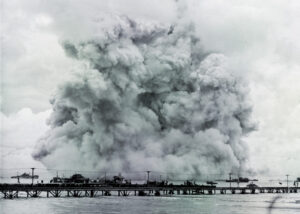A wily old Union seadog drives a final nail into Rebel blockade running.
With the fall of New Orleans in May 1862, Mobile, Ala., became the Confederacy’s most important port city on the Gulf of Mexico, a critical junction for Rebel blockade runners carrying supplies and commerce to and from the Deep South. Rear Admiral David Glasgow Farragut, the Union hero at New Orleans, and Secretary of the Navy Gideon Welles realized immediately they had no opportunity to relax, and within days had turned their energies to Mobile’s capture. For various reasons, they would have to wait until the summer of 1864 for that to become a reality.
The capture of Mobile was actually not as critical as control of the huge bay that protected it. That proved to be a daunting challenge for Farragut’s West Gulf Blockading Squadron over the next two years, as the Confederates did all they could to make life miserable for any enemy vessel bold enough to attempt a run into Mobile Bay. The biggest menace were three forts right on the water: Fort Powell guarding Grant’s Pass and two straddling the bay’s main shipping channel—Fort Gaines on Dauphin Island, with 26 guns, and Fort Morgan, with 46, on Mobile Point. Adding to Union fears was a wide bed of obstructions and mines, or “torpedoes,” the Confederates had strewn in the channel, forcing ships to negotiate a thin stretch of water between the mines and Fort Morgan’s guns.
Farragut drafted his first Mobile attack plan in August 1862. But as the months passed he and Welles faced continued delays, and by the end of 1862 it was clear Union priorities had switched to other theaters of the war. As the conflict entered its third year, in fact, Farragut found himself on the Mississippi helping Ulysses S. Grant take Vicksburg. In January 1864, he was finally free to focus on Mobile Bay again, and by July he had all the pieces nearly in place. The relief was evident in the admiral’s’ voice as he gave his commanders the long-awaited call: “Strip your vessels and prepare for conflict.”
Farragut settled on August 5 for the attack. His fleet began moving at 5:45 a.m., a light breeze blowing in from the southwest and a full tide flowing into the bay. Leading the way were the four Union monitors, followed by the squadron’s 14 wooden gunboats—lashed together in pairs. Farragut had used that ploy successfully at Port Hudson, determining that if a shell disabled a ship, its mate would be able to tow it out of trouble.
Brooklyn–Octorara and Hartford–Metacomet led the seven gunboat tandems, respectively. Farragut wanted Hartford, his flagship, but was advised to give Brooklyn first in line that honor because it was equipped with a “cowcatcher”—a device for clearing obstructions—that might help if the ships veered into the torpedo field.
Just after 7 a.m., Fort Morgan’s gunners opened fire on the ironclads, now about a mile off, drawing a steady response from the Union vessels. When smoke obscured Farragut’s view, the 63-year-old admiral scrambled up the rigging of one of the ship’s sails to get a better look, soon followed by Quartermaster John H. Knowles, who secured him to the rigging with a rope
Perched 50 feet above the deck, Farragut watched anxiously as his attack began to unravel. First, the lead ironclad Tecumseh strayed off course and struck a mine, sinking in a matter of minutes—with 93 crew members perishing. Seeing the explosion, Brooklyn’s captain hesitated, forcing Hartford’s skipper to cut his ship’s engines to avoid a collision. Realizing that Fort Morgan’s gunners would have ample time to pick apart the Union ships if the procession stalled in the channel, Farragut quickly displayed the calm and fortitude that had made him a hero at New Orleans and on the Mississippi and ordered Hartford–Metacomet to steam past Brooklyn– Octorara into the bay.
Though that meant sending his ships through the mines, Farragut never balked, reassuming control of the battle with his soon-to-be-immortal declaration, “Damn the torpedoes…full speed ahead.” Hartford and Metacomet somehow made their run through the mines unharmed. Since several mines had been in the channel for nearly two years, it’s likely water seepage into the casings had rendered their explosives useless.
Waiting in the bay for Farragut were Confederate Adm. Franklin Buchanan’s formidable flagship, the 10-gun ironclad Tennessee, and the side-wheel gunboats Selma, Gaines and Morgan, with 4-6 guns each. After failing in its efforts to ram Hartford, Tennessee attempted to stop the other Union ships following Farragut through the torpedoes. Tennessee, however, soon found itself alone. Morgan and Gaines were quickly taken out of action, and Selma surrendered after failing to outrace the quicker Metacomet—finally unlashed from Hartford—to Mobile’s port.
Like a wounded bear, Tennessee kept up the fight. But the Union numbers were too great. Once the three remaining ironclads pushed into the bay, the end was near. By 10 a.m., the Confederate flagship, severely damaged during a close-range confrontation with the Union ironclad Chickasaw, had no choice but to surrender.
Powell’s garrison evacuated the fort that evening; Fort Gaines surrendered August 8. Farragut’s force laid siege to Fort Morgan for the next two weeks until its commander, Brig. Gen. Richard Page, raised the white flag on August 23. Mobile’s days as a blockade-running port had ended, though the city itself remained in Rebel hands until April 1865, the war all but over.
Chris Howland is Editor of America’s Civil War.
Originally published in the July 2014 issue of America’s Civil War. To subscribe, click here.




